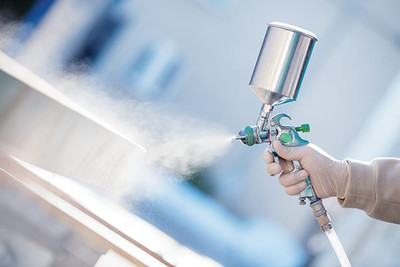2nd Jul 2025
In any paint or spray application process, the way material is delivered to a surface plays a significant role in the final finish. One of the most critical factors in this is atomisation – the process of breaking a liquid into fine droplets. Whether you're spraying protective coatings or decorative finishes, understanding the link between atomisation and coating quality can help ensure better results, minimise waste, and reduce rework.
What is atomisation?
Atomisation occurs when a fluid, such as paint, is forced through a nozzle and broken down into tiny droplets. This transformation is essential for producing a fine, even spray that adheres effectively to a surface.
There are several types of atomisation, each with different methods and results:
- Air atomisation: Uses compressed air to break up paint into droplets.
- Airless atomisation: Relies on high fluid pressure to force paint through a small orifice.
- Electrostatic atomisation: Applies an electrical charge to particles to improve transfer efficiency.
Each method produces a distinct spray pattern quality, which directly influences the appearance and performance of the coating.
Why atomisation matters for coating quality
Poor atomisation can result in an uneven spray pattern, visible defects, and an inconsistent finish. Here’s how the quality of atomisation affects key aspects of coating application:
- Spray pattern quality: Well-atomised paint forms a uniform spray pattern with evenly distributed droplets. This helps avoid issues like streaking, striping, or uneven build-up, which can compromise both the appearance and protective qualities of the coating.
- Surface coverage: Efficient atomisation improves transfer efficiency – how much paint actually lands on the surface rather than becoming overspray. Better coverage means fewer passes, lower material consumption, and a more uniform finish.
- Coating finish: The smoother the atomisation, the finer the droplet size. This directly influences the texture and appearance of the coating, from high gloss to matte finishes. A poorly atomised spray can cause orange peel effects, sagging, or dry spray.
- Drying and curing: Atomised droplets dry more consistently than larger, uneven particles. Consistent drying supports stronger adhesion and a more durable final coat, reducing the likelihood of defects or premature failure.
What affects atomisation?
Several variables can impact spray atomisation, including:
- Nozzle design and condition: Worn or clogged nozzles disrupt atomisation and alter spray patterns.
- Fluid viscosity: Thicker materials may require different pressures or tip sizes to atomise effectively.
- Air pressure and volume: In air-assisted systems, incorrect air settings can cause spitting or inconsistent sprays.
- Equipment maintenance: Regular cleaning and servicing ensure your system performs to its intended standard.
Getting it right
To improve atomisation and coating quality, consider the following best practices:
- Select the appropriate spray system for your coating type.
- Use the correct nozzle and pressure settings based on the manufacturer's recommendations – take a look at our online range.
- Regularly inspect and maintain equipment – schedule your servicing here.
- Train operators on proper spray technique and troubleshooting.
Conclusion
Spray atomisation is more than just a technical detail – it's a foundational element of every high-quality coating application. By understanding how atomised paint behaves and recognising the variables that influence it, you can enhance both the appearance and performance of your coatings. Whether you're working in industrial settings or applying fine decorative finishes, mastering atomisation means fewer issues, better outcomes, and higher customer satisfaction.



